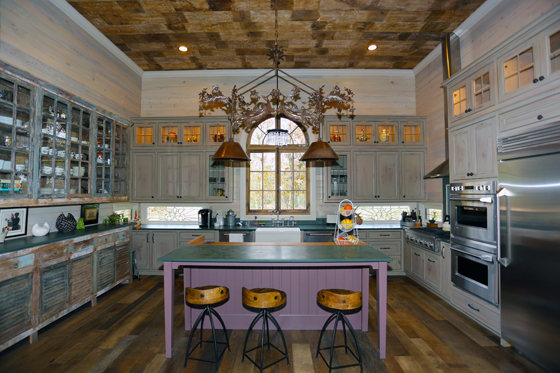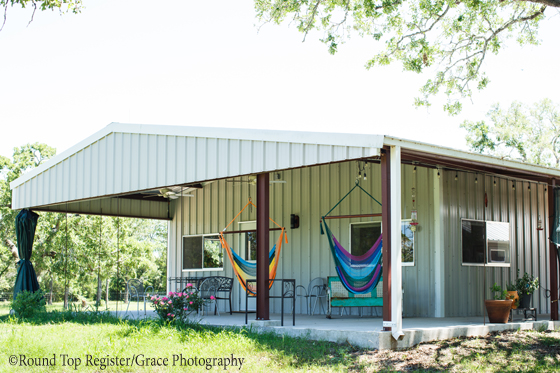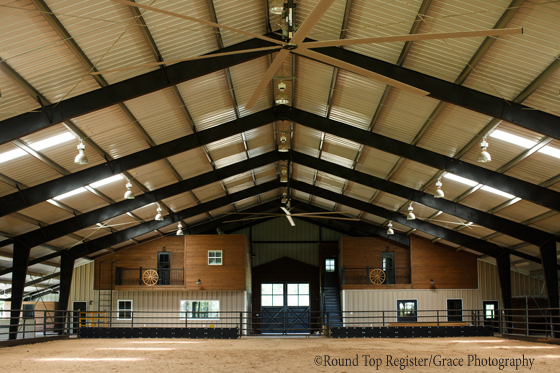Building Country Dream Homes

2024 Spring Antiques Show | March 14 – 31
2024 Fall Antiques Show | October 10 – 27
Country dream homes are as unique as the people who dream of country living.
While some of the dreamers have family roots that have anchored them in the Roundtopolis for generations, many dreamers come from Houston and its suburbs. Austinites, who traditionally have headed west to the Hill Country, are beginning to discover the beauty that lies to their east.
Whether they are building on two acres or 200, generally the dreamers consider their homesteads an investment, both financial and emotional, in their futures. Strong demand for rural land with urban access supports property values even when the overall economy slows. Country living with family and friends makes memories.
 Fortunately, for those who are drawn to the Roundtopolis, there is a host of talented craftsmen with the skills and vision to help make dreams come true. We convinced our construction-minded advertisers to put down the tools of their respective trades long enough to share their expertise with us—and you.
Fortunately, for those who are drawn to the Roundtopolis, there is a host of talented craftsmen with the skills and vision to help make dreams come true. We convinced our construction-minded advertisers to put down the tools of their respective trades long enough to share their expertise with us—and you.
Our experts, in alphabetical order, include: William Amelang, Portable Buildings of Brenham, a division of Discount Trees, Brenham; Tim Brown, Tim Brown Architecture, Austin; Wes Bryant, Texas Casual Cottages, a division of Partners in Building, Houston; David Dunlap, Dunlap Welding and Fabrication, Round Top; David Elliott, Elliott Construction, Carmine; Cori Kmiec and Greg Thompson, Cross Creek Construction and Design, Burton; Lewis Tindall, Tindall General Contractors, La Grange; Dana Weidemann and Jordan Weidemann, Total Residential Services, Round Top; and Matt White, Recycling the Past Architectural Salvage, Round Top.
While some individuals choose to break new ground with their home’s design, most embrace the region’s signature farmhouse style. The appeal of watching the sun set from a porch is hard to resist. Some want the satisfying challenge of restoring a 19th century treasure while many want new construction and modern conveniences delivered with time-tested style. Others elect options ideally suited to the country such as barndominiums or custom-built pier-and-beam portables that are delivered to the site.
Custom Construction
The dominant trend in custom construction is “total customization” meaning builders are delivering exactly what customers want.
“As custom builders, we’re all just learning to say yes to what customers want—and then delivering those one-of-a-kind elements,” said Wes Bryant of Texas Casual Cottages by Partners in Building.
This can mean including combination laundry and mud rooms that are as big dining rooms or constructing bunk rooms to accommodate a lot of guests or conceiving a design that showcases antique elements such as 11-foot imported folding doors or working with tongue-and-groove wood such as pecky pine or installing outdoor showers or building custom furniture along with the home.
 Dana Weidemann of Total Residential Services said, “There is nothing cookie cutter about what we do. Every job is a unique, one-of-a-kind project. We challenge ourselves to make each one different by designing it to fit our customers.”
Dana Weidemann of Total Residential Services said, “There is nothing cookie cutter about what we do. Every job is a unique, one-of-a-kind project. We challenge ourselves to make each one different by designing it to fit our customers.”
Lewis Tindall of Tindall General Contractors echoed the sentiment, “The Round Top area is truly a custom market. While no two projects are the same, our clients generally want a farm-style house using the best components available in their budget range.”
The Home-Building Process
Determining exactly what clients want and need from the project’s beginning is the key. Planning time is never wasted because clear direction from the outset saves time during construction.
“While we can always accommodate changes during construction, it is much easier and less expensive to make the changes on paper before we ever begin,” said Cori Kmiec of Cross Creek Construction and Design.
One of the big things people need to consider is how their property will be used. Primary residences may have different requirements than recreational properties.
“People who create getaway properties find themselves entertaining guests much more often than they might expect, so it’s important to consider flow and space for guests,” Kmiec said. “While you don’t want to overbuild, you don’t want to under build.”
 The people who choose new construction tend to embrace retro-mod, meaning their homes look like historic farm houses but have all the modern conveniences including superlative energy efficiency.
The people who choose new construction tend to embrace retro-mod, meaning their homes look like historic farm houses but have all the modern conveniences including superlative energy efficiency.
“Our clients want an open kitchen, dining and living room to gather family and friends in the same space,” Bryant said. “They want high ceilings, reminiscent of homes built before air conditioning, but they want energy efficient heating and cooling and other modern touches—country style with comfort is the order of the day.”
Custom country homes often become the centerpieces of country estates that develop over time. David Elliott of Elliott Construction said, “In some cases, people start by building a barn or guest quarters and then construct their dream home. In other cases, people start with the home and then add other structures over time. Either way, it’s often a long-term project, which means a long-term relationship between clients and their builders.”
Elliott has clients with whom he has worked for years, building additional structures as their budgets and plans allowed.
“When you’re a builder, people are trusting you with one of their largest assets. You have to construct and maintain a strong relationship as surely as you construct a sturdy home.”
David Elliott
In construction, particularly in a rural area, reputation matters. Builders get a majority of their work from repeat customers and direct referrals.
Jordan Weidemann of Total Residential Services said, “Reputation counts. It’s what we live by, especially in a small town. Even though there aren’t inspectors looking over our shoulders out here, we do everything to code—and above—because it’s the right way to do business.”
Build times depend on a variety of factors including weather, but the experts agreed nine to 12 months from start to finish on a new build or extensive renovation is an accurate estimate. Smaller scale remodeling projects can take less time. While some builders have a wait time, others are available to begin working on new projects immediately. All agree the economic slowdown hasn’t negatively affected their workloads.
Bryant said, “People are still building their dreams.”
Restoration, Renovation and Remodeling
The three r’s of construction—restoration, renovation and remodeling—bring their own challenges and rewards.
Jordan Weidemann, who along with his business partner embraces the challenges of renovations, said, “There’s nothing we can’t do or won’t try. We’re happy to tackle any job a client can imagine.”
Although most of the original farmhouses in the immediate Round Top area have already been restored, moved or demolished, they are still plentiful in the region. Because they are built on pier-and-beam foundations, they can be moved. Depending on the client’s wishes, the old homes can be restored to serve as the primary residence or a guest house, or they can serve as the “anchor space” for an expansion.
“Before we ever start a restoration project, I tell customers to expect the unexpected,” Tindall, who estimates about half his business is restoration, said. “Every day is a chance for a new challenge.”
With older homes contractors don’t know exactly what they will find until they tear into the project. The older the home, and the longer it’s been out of use, the more likely there may be “hidden” expenses related to the home’s structural integrity or basic systems such as electrical and plumbing.
“Renovation can be expensive because it requires a contractor to do three separate things: we are taking it apart, putting it back together and adding new elements,” Tindall said.
If clients want to use all antique building materials, this can also add to the overall expense. The materials may cost more to acquire, and they may require additional labor to prepare. For instance, on one of the Weidemanns’ favorite jobs, they moved an old house to a new site, reclaimed the interior wood, repurposed it and used it to build the staircase and cover the walls.
Because the costs of a renovation project can change as the project progresses, it is difficult to provide a firm budget at the beginning.
“When it comes to restoration, we prefer to operate on a cost-plus basis simply because we don’t know what we will get into, but we will work from a bid if that’s the customer’s preference,” Dana Weidemann said. “The bid will reflect the reality—and our knowledge—that renovations can involve the unexpected.”
Of course, for those who want uniqueness, the benefits of time-tested materials bring an authenticity to the space that is priceless.
“They just don’t make these old materials anymore,” Tindall said. “For people who like the character of time-worn wood and handcrafted elements, there is nothing more satisfying than being surrounded by them day after day.”
Barndominiums
Barndominiums, the now common combination of barns and living quarters, got their start on horse farms. Farm owners began incorporating apartments for hired hands into the barns. Then they began adding office space and break or meeting rooms, said David Dunlap, owner of Dunlap’s Welding and Fabrication, who got his start building horse barns. Today, a majority of his barndominium clients still are horse enthusiasts.
“Eventually, people said, ‘Hey, we can live in that,'” Dunlap said.
 Cori Kmiec and her father Greg Thompson of Cross Creek Construction and Design build barndominiums and arenas as well as custom wood-frame homes. While some of their clients are in the horse industry, others use the “barn” space as equipment storage, a workshop or for hobbies such as auto restoration.
Cori Kmiec and her father Greg Thompson of Cross Creek Construction and Design build barndominiums and arenas as well as custom wood-frame homes. While some of their clients are in the horse industry, others use the “barn” space as equipment storage, a workshop or for hobbies such as auto restoration.
Kmiec said, “When people buy a place in the country, they want to be able to enjoy it quickly—and barndominiums offer that option. It’s funny, though; many people start out planning to use the barndo as a temporary home and end up making it permanent.”
Generally, barndos are metal frame construction. Metal frame construction is faster than wood frame. Dunlap, who fabricates his own metal framework, estimates that site prep, depending on weather, takes about three weeks and the actual building construction, depending on size, takes 30 to 60 days. Then the interior finish work, which his firm doesn’t handle, can begin.
“The interiors can be finished with the same level of detail and same materials as a wood frame building,” Thompson, whose firm performs interior finish work, said. “The interiors can be as simple or as elaborate as the client desires.”
Cross Creek Construction and Design often uses a combination of wood, stone and metal to create an elegant exterior with a country feel.
 With appropriate insulation, metal frame buildings can be very energy efficient. Metal frames can also span larger expanses than wood, and metal buildings need less maintenance because they are resistant to insects and metal siding doesn’t require painting.
With appropriate insulation, metal frame buildings can be very energy efficient. Metal frames can also span larger expanses than wood, and metal buildings need less maintenance because they are resistant to insects and metal siding doesn’t require painting.
While some clients come to meetings with very detailed, dimensional drawings, Dunlap noted that rough sketches sometimes work better.
“The metal components come in certain lengths,” Dunlap said. “If I can work using those lengths instead of cutting them down into ‘oddball’ sizes, I can often give people some additional space for less money.”
Custom-Built Pier-and-Beam Buildings
Custom-built pier-and-beam buildings provide a cost effective, time sensitive option, said William Amelang with Portable Buildings of Brenham. They are also easy to repair and maintain. People are using them for residences, guest lodging, offices, barns, she sheds, man caves, pool houses and more.
“In addition to being adapted to many uses, our pier-and-beam buildings also offer a tremendous amount of flexibility to respond to economic changes,” Amelang said. “When you need to move your family or business, it’s better to have the ability to take your building with you.”
“Our homes are a more spacious version of a tiny house-there’s actually enough room inside for people to stay married.” William Amelang
About 50 percent of the buildings are used for residences while 50 percent are used for recreational or commercial buildings.
They are wood-framed using full-size materials. Clients select a floor plan, mark their changes to customize the building, and choose their colors, fixtures and finishes. The standard exterior is a fire-resistant steel siding that carries a 40-year warranty.
 “Then people can sit back and relax for six to 10 weeks until we deliver the finished building to their site,” Amelang said. “It’ll be ready to ‘plug in’ to their electricity and water hook ups.”
“Then people can sit back and relax for six to 10 weeks until we deliver the finished building to their site,” Amelang said. “It’ll be ready to ‘plug in’ to their electricity and water hook ups.”
The buildings, which can be up to 1,200 square feet, don’t require a building pad. The finished cost with appliances ranges from $60 to $90 per square foot.
“We’ve been in business for more than 30 years, adding pier-and-beam homes to our offerings about 10 years ago,” Amelang said. “Efficient, affordable housing is a growth sector.”
Architectural Salvage
Architectural salvage is ultimate recycling. Salvagers reclaim unique architectural elements including flooring, windows, doors, lighting, woodwork and antique built-ins primarily from old buildings that are slated for demolition, although industrial sites, military surplus and even aircraft yield treasures.
“Architectural salvage is green because we’re reclaiming, repurposing and reusing material, and in the process we’re keeping history alive,” said Matt White, owner of Recycling the Past based in Round Top and Barnegat, New Jersey. “They don’t make materials like this anymore, so people who choose to incorporate salvaged elements not only enjoy high-quality but are able to make a very personal style statement.”
 For people who are building new homes or businesses, White noted that reclaimed wood floors, beams, light fixtures, doors and windows are simple ways to incorporate old materials into new spaces. One hot and easy to incorporate trend is “cladding” walls with reclaimed wood. Other elements such as staircases, built-in cabinetry or large focal point items take some pre-planning.
For people who are building new homes or businesses, White noted that reclaimed wood floors, beams, light fixtures, doors and windows are simple ways to incorporate old materials into new spaces. One hot and easy to incorporate trend is “cladding” walls with reclaimed wood. Other elements such as staircases, built-in cabinetry or large focal point items take some pre-planning.
“Using architectural salvage inspires creativity,” White said. “These items were built for a previous space, so the new owners may have to adapt the materials to the space with some slight alterations.”
With big pieces, White suggests enlisting the architect and/or contractor early on to ensure the piece is incorporated into the space seamlessly. In his experience, some building professionals enjoy working with architectural salvage while others don’t, so it’s important to have this discussion in the planning stages.
Like so many custom features, the expense of architectural salvage materials depends on what is involved.
“Sometimes the materials are more expensive, but sometimes they are less expensive,” he said.
White is of the opinion that the payoff comes in having a unique living and work space where the owner can enjoy the value of the item. Some of the artifacts will appreciate over time like fine artwork and can be a good commodity for the long term, while the box store items are an expendable product.
“Architectural salvage isn’t for everyone, but it is for those people who want to make a historic style statement,” White said. “To them I say buy what you love because it’s going to be part of your life. Architectural salvage lends itself to so many things; the only limits are the budget and creativity.”
Architecture
Good architects engage their clients in a collaborative process designed to provide them with a one-of-a-kind home that satisfies their wants and needs.
“Early on, we go through a list of questions that helps us extract information—including things they may have never considered—from our clients about the home they envision,” Tim Brown of Tim Brown Architecture said. “It’s the beginning of a give-and-take process that gets to the heart of what they want in home.”
The design process’s length is dictated by the client’s schedule, their ability to identify and articulate their needs and the project’s complexity. In some cases, Brown has produced complete plans in as little as three months, but in other cases the project has extended to a year.
From Brown’s standpoint the design process works best if the clients provide a budget, which will determine the project’s scope, and samples of their style such as photos from Houzz or Pinterest, but avoid bringing in house plans.
“Photos are conceptual and help establish style while house plans are concrete and inadvertently establish creative boundaries,” Brown, who estimates 80 percent of his projects are single-family residences, said, “Determining individual style can be hard, but once the style is established, we can plug in function all day long.”
Like clients, most architects have a favorite style.
“Architecture is built on proportion and scale overlaid with style,” Brown said. “Most architects have a favorite style and while they can interpret the ‘language’ of others, it may not be their best work. Although I can design a glass cantilevered house, I’m probably not the best guys for that job.”
Brown, a native Texan who was reared in rural Maine, prefers the clean, simple lines of New England Colonial and Victorian, which are very similar to the German Victorian folk style that characterizes the Roundtopolis. He is in the process of opening a satellite office in Bellville.
“I really believe in the spirit of a place,” Brown said.
According to Brown, one of the biggest “mysteries” about working with an architect is the cost. Architects charge a percentage of the project’s building cost. The fee can range from 8 percent to 25 percent for a full-service architect.
An architect, in addition to providing custom-designed house plans, also serves as an objective project advisor and can assist clients with everything from interviewing builders and obtaining permits to overseeing the project.
“Hiring a full-service architect is a big investment, but the result is an heirloom house—a one-of-kind piece of art—that will be enjoyed for generations,” Brown said.
The Bottom Line
Whether it’s new construction, a renovation or an eclectic option, one fact remains for both building professionals and their clients.
“People come here to live their lives to the fullest,” Dana Weidemann said. “Our goal is to create a setting where they can do that-and make a lot of good memories along the way.”
 See our Q&A With the Experts.
See our Q&A With the Experts.
by Lorie Woodward Cantu
photos by Anna Spencer Morse, Grace Photography
photos by Dixie Ray Hamilton, Dixie Ray Photography
2024 Spring Antiques Show | March 14 – 31
2024 Fall Antiques Show | October 10 – 27